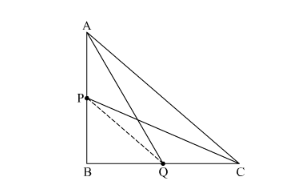In a right triangle ABC right-angled at B, if P and Q are points on the sides AB and AC respectively, then
In a right triangle ABC right-angled at B, if P and Q are points on the sides AB and AC respectively, then
(a) $\mathrm{AQ}^{2}+\mathrm{CP}^{2}=2\left(\mathrm{AC}^{2}+\mathrm{PQ}^{2}\right)$
(b) $2\left(\mathrm{AQ}^{2}+\mathrm{CP}^{2}\right)=\mathrm{AC}^{2}+\mathrm{PQ}^{2}$
(c) $\mathrm{AQ}^{2}+\mathrm{CP}^{2}=\mathrm{AC}^{2}+\mathrm{PQ}^{2}$
(d) $\mathrm{AQ}+\mathrm{CP}=12 \mathrm{AC}+\mathrm{PQ}$
Disclaimer: There is mistake in the problem. The question should be "In a right triangle ABC right-angled at B, if P and Q are points on the sides AB and BC respectively, then"
Given: In the right ΔABC, right angled at B. P and Q are points on the sides AB and BC respectively.

Applying Pythagoras theorem,
In ΔAQB,
$\mathrm{AQ} 2=\mathrm{AB} 2+\mathrm{BQ} 2$....(1)
In ΔPBC
$\mathrm{CP}^{2}=\mathrm{PB}^{2}+\mathrm{BC}^{2}$.....(2)
Adding (1) and (2), we get
AQ2+CP2=AB2+BQ2+PB2+BC2 .....(3)
In ΔABC,
$\mathrm{AC}^{2}=\mathrm{AB}^{2}+\mathrm{BC}^{2}$....(4)
In ΔPBQ,
PQ2=PB2+BQ2 .....(5)
From (3), (4) and (5), we get
AQ2+CP2=AC2+PQ2
We got the result as (c)
Click here to get exam-ready with eSaral
For making your preparation journey smoother of JEE, NEET and Class 8 to 10, grab our app now.
